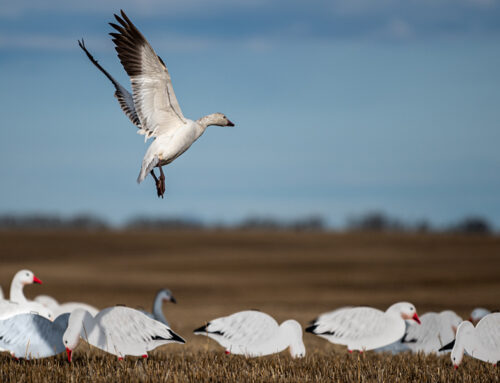5 Creek and Ditch Setups for Ducks
 By Tom Carpenter
By Tom Carpenter
Sit back for a moment, close your eyes, and picture the most classic piece of duck hunting water your mind’s eye can produce.
What do you see through the first shooting light of a new day?
Perhaps it’s a quiet and secluded pool in a lost corner of a sprawling marsh. Maybe it’s a timber-lined riverbottom oxbow, far off of the radar of other hunters. Flooded timber itself could be your go-to dream spot, as could a field of flooded rice, corn or soybeans. Out on the wide-open prairie, a cattail-rimmed slough surely gets many nods.
But I’m willing to bet a box of high-speed steel No. 4 shot that pint-sized streams, little creeks, ordinary drainage ditches and similar ribbons of small water didn’t make many hunters’ visions.
That’s just fine by me and other puddle duck hunters with an affinity for small water who are looking to:
- Find ducks when the pressure is really on in the classic spots where everybody else is hunting hard.
- Hunt ducks in places where traditional waterfowl water just doesn’t exist, and streams, creeks and/or ditches may be the only habitat around.
- Leverage the opportunity of migrating birds coming through an area not otherwise known for its duck hunting.
Quiet Water
When the shooting begins, puddle ducks learn fast. They just don’t keep trying to get back on the now-unfriendly water that used to be so quiet and safe. Ditches and creeks — even when miles away from hard-hunted spots — offer seclusion and safety to ducks.
Tip: Don’t give up on “escape” creeks and ditches too early in the day. These spots really come in to their own after shooting light is well established and ducks have had a chance to retreat. Plus, birds will often move and reposition until mid-morning.
Only Water
For many duck hunters, classic water just doesn’t exist, especially if you’re looking for a quick morning or evening hunt close to home. Where I grew up in southwestern Wisconsin, this was the case: The Mississippi River backwaters were a 60-mile drive, the Wisconsin River was 40. Creeks and ditches were the name of the waterfowl game in the hilly dairy farm country near home.
Tip: Scout multiple likely spots before duck season so you don’t have to hunt the same hole two mornings in a row. For example, I maintain a small “milk run” of wood duck creeks feeding into the Minnesota River near home.
Migration Stopover
No matter where you live, migrating ducks can pop in for a few sleepovers and feeding sessions at any time of fall. If you see birds coming through, visit local small waterways and hunt at either end of legal shooting hours.
Tip: Put together a team of reliable duck-watchers (rural mail carriers, milk truck or grain truck drivers, farmer friends and other landowners come to mind) who will let you know when ducks are flying. You can also watch water close to home.
Cast of Characters
Ditches and creeks are the realm of puddle ducks. Diving ducks are rare in these situations, although the occasional ring-necked duck might show up. But mostly you’ll be dealing with wood ducks, teal (bluewings seem to like small water more than greenwings) and mallards. Gadwalls are another candidate. Small waters can attract pintails too, when hunting pressure on bigger water threatens their elegant feathers.
The Setups
CREEK BEND
Creek bends give you the ability to watch a couple stretches of water. Place yourself on the outside of the bend so you can see down both those stretches. Drop small pods of three to four decoys each down either stretch, leaving a landing hole in front of you at the bend.
STREAM STRAIGHTAWAY
Some streams and ditches, for that matter, don’t have much curve or variation to them. Place a loose pod of six to eight decoys. Position yourself downwind, where you can shoot incoming ducks putting down the landing gear as they approach and try to drop in short of the dekes.
EDDY or POOL
Points, bends, curves and other variations on slightly larger streams can create a pool or eddy with calm or “backwash” water that invites ducks to rest out of the current. Place a small pod of four to five decoys right in the eddy, and put a couple attractor blocks out on the stream for more visibility. Position yourself on the outside of the bend if possible, where you can see into the eddy, as well as up and down both stretches of stream.
HIGHWATER SPILLOVER
When autumn rains gush, streams and ditches overflow. Ducks — especially woodies — love the resulting habitat. Set up on an overflow pond using eight to 10 wood duck decoys. Place three to four of them close to edges or right on the bank, and toss the other blocks randomly, leaving a landing hole in the middle.
DITCH INTERSECTION
In a large wetland or lowland crop complex, there’s usually more than one ditch. Find the intersection of a couple waterways, and you’ve found more water to attract ducks. Place a brace or trio of decoys down each branch, and stake a spinning-wings decoy right on the intersection. Hide where you can see the opening and as many of the legs of water as possible.



Great article! Very informative thank you. Keep them coming.
I’m a new comer to the duck hunting world and tried creek hunting last year killed a couple woodies and had several come in the creek bend set up is poison to those woodies great advise